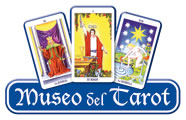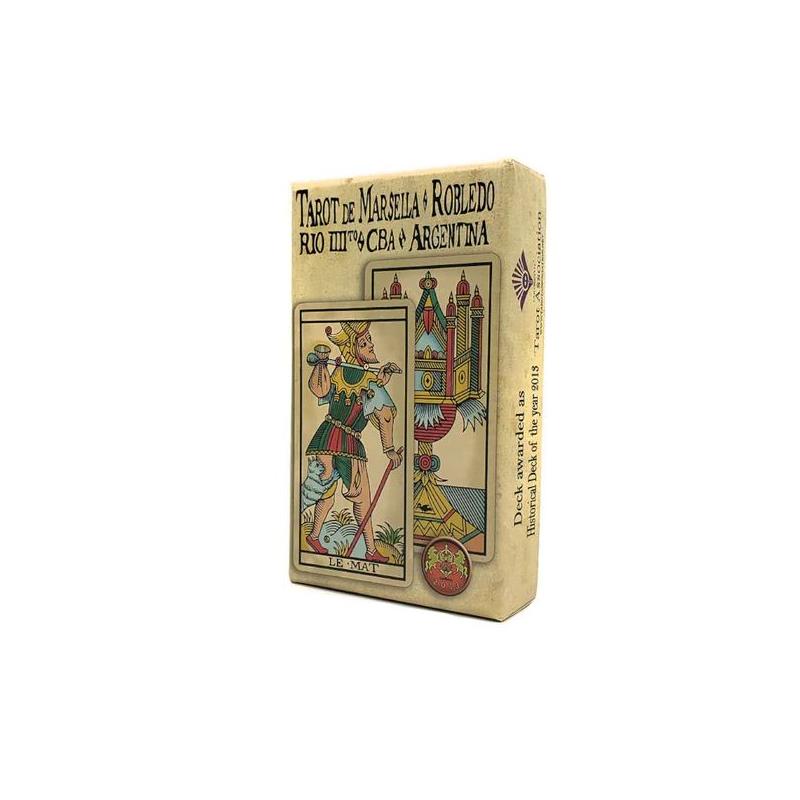El Tarot de Marsella Robledo es fruto de una idea que nació en 2008: desarrollar un TdM II, en base a lo que entendía en ese momento lo que era y debía contener un TdM y que a la vez fuese una herramienta útil para la lectura.
Con ese anhelo de crear un TdM que fuera lo que yo entendía debía ser, me puse manos a la obra y comencé a desarrollar una síntesis de los mazos mas bellos e interesantes de los que componen a esa tradición , tras haber avanzado bastante en el trabajo, lo pospuse por cerca de dos años para dedicarme al estudio y restauración del Tarot de Jean Dodal. Esta experiencia profundizó bastante mis conocimientos del Tarot y, entonces, pude retomar con mejor experiencia mi trabajo en el TdM II, el cual vio la luz a fines de 2011 en su primera edición
A los pocos meses de haber publicado esta primera edición, con la cual estaba muy conforme, recibí una copia del tarot de Pierre Madenié editado por Yves Reynaud y Wilfried Houdouin. Este mazo me confrontó con un enfoque diferente de los símbolos y detalles del TdM, por lo que emprendí una revisión de mi propio trabajo.
A partir de esta nueva adquisición, hice algunas modificaciones importantes, tales como la apariencia de la pintura, un mejor calibrado de los colores para facilitar la lectura con menos luz o incluso para ser leída con luz de velas, entre otras consideraciones y disposiciones que guiaron este nuevo esfuerzo.
Todo este trabajo se tradujo en una segunda edición, que estuvo lista para el año 2012.
Un proceso similar se produjo con la tercera edición, que está mucho más cerca de la idea original que tenía para el mazo. En ella, modifiqué la textura en el papel y algunos de los efectos del envejecimiento y la forma de pintado, en lo que traté de simular el trazo de un pincel. También, esta tercera edición se vio influida por muchos detalles cercanos al estilo Suizo de cartas, que sin ser originarias de este país están ligadas muy estrechamente al estilo del TdM. Esta edición fue premiada por la Asociación Tarosófica en el año 2013.
Pero antes de enterarme de que esta edición había sido galardonada, empecé mi trabajo para la cuarta edición gracias a varias observaciones de Bertrand Saint-Guillain acerca de la apariencia que tiene la tinta en la estampa de las cartas.
Todas estas cuatro ediciones fueron impresas en una forma muy artesanal y personal, que circula en privado y en ediciones muy pequeñas.
En 2014 comencé mis estudios de xilografía, y ya para fin de ese año con el pulso y los trazos mas seguros y definidos comencé a grabar los 22 arcanos mayores en madera, como método de estudio personal y así poder entender de una manera más íntima la verdadera forma que tienen los trazos y conocer de una manera más real la verdadera apariencia de la tinta como estampa sobre el papel.
Cuando estaba volcado de lleno a los detalles de este trabajo, entonces, coincidentemente conocí a Cesar Gamboa, quien junto a su equipo, trabajó conmigo en la producción de una nueva edición del TdM II que ya llevaba cuatro ediciones y que hoy se conoce como el Tarot de Marsella Robledo.
Cesar Gamboa, un verdadero apasionado por el buen Tarot, se acercó a mí por primera vez como alguien interesado en mi trabajo, en la adquisición de algunos ejemplares de los mazos que yo tenía disponibles. Fue luego de recibir algunas copias de la cuarta edición del Tarot de Marsella Robledo que me presentó una propuesta para la publicación de una edición de mayores proporciones y con mayores recursos técnicos.
Fueron muchas las decisiones que se debieron tomar, incluyendo el tipo de impresión, la calidad del papel, la intensidad de los colores y todos los demás detalles que dan vida e identidad al mazo. En todo este proceso de producción, mi opinión fue considerada, así que en gran modo sigue manteniendo toda esa atención y preocupación por el detalle que se invierte en la elaboración más artesanal.
The Tarot de Marseille Robledo is the result of an idea that was born in 2008: to develop a TdM II, based on what I understood at that time what a TdM was and should contain and that, at the same time, was a useful tool for reading.
With that desire to create a TdM that was what I understood it should be, I got down to work and began to develop a synthesis of the most beautiful and interesting decks that make up that tradition, after having advanced a lot in the work. , I postponed it for about two years to dedicate myself to the study and restoration of the Jean Dodal Tarot. This experience greatly deepened my knowledge of the Tarot and, then, I was able to resume my work in the TdM II with better experience, which came to light at the end of 2011 in its first edition.
A few months after publishing this first edition, with which I was very pleased, I received a copy of the Pierre Madenié tarot edited by Yves Reynaud and Wilfried Houdouin. This deck confronted me with a different approach to ToM symbols and details, so I undertook a review of my own work.
From this new acquisition, I made some important modifications, such as the appearance of the painting, a better calibration of the colors to facilitate reading in less light or even to be read with candlelight, among other considerations and provisions that guided this new effort.
All this work resulted in a second edition, which was ready for the year 2012.
A similar process occurred with the third edition, which is much closer to the original idea I had for the deck. In it, I modified the texture on the paper and some of the effects of aging and the way of painting, in which I tried to simulate the stroke of a brush. Also, this third edition was influenced by many details close to the Swiss style of cards, which without originating from this country are closely linked to the TdM style. This edition was awarded by the Tarosophical Association in 2013.
But before I found out that this edition had won an award, I began my work on the fourth edition thanks to several observations by Bertrand Saint-Guillain about the appearance of ink on card stamps.
All these four editions were printed in a very handcrafted and personal way, circulating privately and in very small editions.
In 2014 I began my xylography studies, and by the end of that year with the safest and most defined pulse and strokes I began to engrave the 22 major arcana on wood, as a personal study method and thus be able to understand in a more intimate way the true form that the strokes have and to know in a more real way the true appearance of the ink as a print on the paper.
When I was fully devoted to the details of this work, then, coincidentally, I met Cesar Gamboa, who together with his team, worked with me in the production of a new edition of TdM II that had already gone through four editions and is now known as the Robledo Marseille Tarot.
Cesar Gamboa, a true lover of good Tarot, approached me for the first time as someone interested in my work, in acquiring some copies of the decks that I had available. It was after receiving some copies of the fourth edition of the Tarot de Marseille Robledo that he presented me with a proposal for the publication of a larger edition and with greater technical resources.
There were many decisions that had to be made, including the type of printing, the quality of the paper, the intensity of the colors and all the other details that give life and identity to the deck. Throughout this production process, my opinion was considered, so in a great way it continues to maintain all that attention and concern for detail that is invested in the most artisan production.





